Hungarian red wines are getting traction and popularity in Europe due to their great quality. It is worth knowing what blends and varieties can be taken into consideration when discussing Hungarian red wines.
Hungary has traditionally been a white-wine-producing country, but four wine regions were specifically red-dominated during the 19-20 centuries: Sopron, Eger in the north and Szekszárd, Villány in the south. By today almost all the Hungarian wine regions have a great selection of red wines. Even Tokaj can show you Pinot Noirs that are worth trying. However, they are running under the “Zemplén” label, because under Tokaj’s label, only white wines are allowed.
History of Hungarian red wines
In the Middle Ages, Hungarian red wine production was modest, mainly due to climatic conditions and technological difficulties. With the advance of the Ottoman Empire, the Serbs who fled brought with them the Kadarka grape and the technology to process and preserve the wine.
The bunches were crushed in large open vats, and the dregs that rose to the top were then stamped with mud to prevent further oxidation. The necessary quantity was drained through small holes in the bottom of the vats to ensure continuous use. This grape-processing technology was spread in the area occupied by the Turkish Empire and can still be found in Villány in the hands of a few small producers.
The Turkish occupation is also remembered as a period of decline in wine production and the country in general. Many previously famous and admired wine regions were destroyed (Szerémség). After the liberation of the capital city, production boomed, and German settlers arrived in the formerly important wine-producing regions to replace the population who had been killed, deported, or fled. Their descendants are still producing excellent wines successfully in Szekszárd and Villány, among other places.
We know the names of the traditional Hungarian red varieties from pre-Filoxé times beside Kadarka there are still a few in cultivation today: Kékfrankos (Blaufränkisch) and Portugieser. We have a few relatively well-known varieties from descriptions but not in production like Kék Bajor (Blue Bavarian) and Bakator. And we have few that come back to production thanks to determined producers. These varieties survived either in the vineyards of a single producer or in the plantations of research institutes. Noteworthy ones from this category are Csókaszőlő, which was widespread throughout the Carpathian Basin before the Phylloxera disaster and is still available from some producers, including Vylyan Winery, which we also sell, and Fekete Járdovány, also from Villány, which is produced by A. Gere Winery.
Today’s Hungarian red wine production is partly based on varieties known before the phylloxera and partly on introducing French varieties (Cabernet Sauvignon, Cabernet Franc, Merlot, Syrah, Pinot Noir). With the increase in climate change, varieties adapted to a much warmer climate are also appearing. Excellent wines based on Sagrantino, Tannat, Tempranillo, and Sangiovese are produced in Hungarian wineries. Bordeaux-style blends are also becoming increasingly common, often more powerful and full-bodied than the wines from southern France. This tendency can be observed in Villány and the South Balaton wine regions.
The most essential Hungarian blends and varieties are listed below.
Bikavér (Stierblut, Bull’s Blood)
Bikavér (Stierblut, Bull’s blood) was used to describe strong, deep-colored wines throughout the country from the beginning of the 19th century. Its first official mention dates back to 1846 in a poem by János Garay, a poet from Szekszárd. And a collection of sayings refers to bull’s blood as an indication of strong, deep-colored wines, such as the red wine from Eger.
From the mid-19th century, the appellation became a brand name and was used primarily for red wine blends in the area around Eger. It is well known that in most red wine-producing regions, to balance the fluctuating quality of Kadarka wines from year to year, producers have started to blend their wines. The result is a deep ruby color, spicy, medium-bodied red wine. The Bikavér brand name is now permitted in Eger and Szekszárd, and the product specifications strictly regulate which wines may bear the word and its subcategories.
The backbone of the Bikavér blends is no longer Kadarka but Kékfrankos (Blaufränkisch) grapes, but in both places, the addition of Kadarka to the combination is allowed. In Szekdszárd, it is compulsory.
In Eger, excellent Bikavérs are also produced at St. Andrea Winery, Marcell Bukolyi’s Organic Winery, Kovács Nimród Winery, Tibor Gál Winery, Ferenc Tóth Winery, and Bolyki Winery.
In Szekszárd, the Bikavér wines of the Sebestyén Winery are definitely worth a visit: the Mozaik and the vineyard selected Bikavérs. In addition, the Bikavér of Péter Vida, Heimann Winery, Szeleshát Winery, and Lajvér Vineyard are also excellent choices.
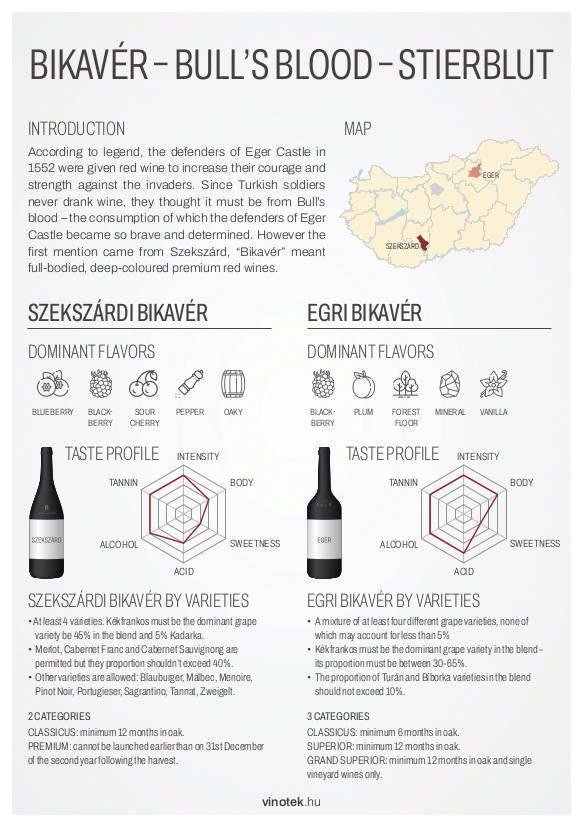
Kékfrankos (Blaufränkisch)
The exact origin of Kékfrankos is still unknown but most likely to be within the area of the ex-Austro-Hungarian Empire. It is the variety first mentioned in Hungary in 1890.
Kékfrankos is Hungary’s most planted grape variety by far. It is a country-wide variety. Plantings are almost all over in Hungary. The total vineyard area in Hungary was 8011 ha in 2019.
It gives a medium-structured wine with crispy-high acidity, medium (silky) tannin and body, and medium flavor intensity. The dominant flavor characteristics are sour cherry, cherry, red currant, raspberry, rose pepper, some herbal notes, and most of the time, some tobacco, coffee, and sweet spice notes due to the oak. The traditional Hungarian Kékfrankos have been aged in an oak barrel for 6 to 12 months. Generally, oak aging in southern regions, such as Szekszárd and Villány, is more significant than in North-Western areas, such as Sopron.
Kékfrankos is especially important in the historical, regional blend of Bikavér (Bull’s Blood) in the Eger and Szekszárd regions. Also, regarding Hungarian Rosé, Kékfrankos is by far the most important grape variety. Popular in Central-Eastern Europe, with good international potential among the mid-structured, indigenous varietal red wines market category.
Kadarka
Kadarka is a standard variety in Hungary, Serbia, Romania, Bulgaria, Macedonia, as well as Albania and goes by different names in each country, such as Kadarka (Hungary), Skadarka (Serbia, Croatia), Cadarca (Romania), Gamza (Bulgaria) and Kallmet (Albania). The exact origin of the variety is still uncertain but lies somewhere within the Balkan- Pannonian area. Kadarka was most likely brought into Hungary by the Serbs during the Ottoman Occupation. Although Kadarka is not an indigenous Hungarian grape variety, it has become an essential regional black grape variety.
In 2021 Kadarka’s total vineyard area in Hungary was 274 hectares. The variety’s most important wine regions are the Kunság and Szekszárd in the country’s southern area. It used to be the most essential varieties in Eger’s Bull Blood in the 19th century, but it eventually was replaced by Kékfrankos in that blend. Now it plays a more critical role in the Szekszárd region, where Zoltán Heimann Jr. calls himself “Kadarka Man “.
Many refer to Kadarka as Hungary’s answer to Pinot Noir. It is not a coincidence. Wine made of Kadakra has a medium-vivid acidity, restrained tannin level, and light to medium body. It has fresh red berry fruit notes, like raspberry, redberry, and sour cherry, with spicey paprika notes and a hint of herbal touch.
Both reductive and light oaky wine stypes are common due to their soft body and vivid acidity with fresh red fruits. Vital oak aging doesn’t fit well with Kadarka.
In our shop, there are a couple of single variety bottles from Szekszárd, and it also plays a role in Bull’s Blood wines both from Eger and Szekszárd.
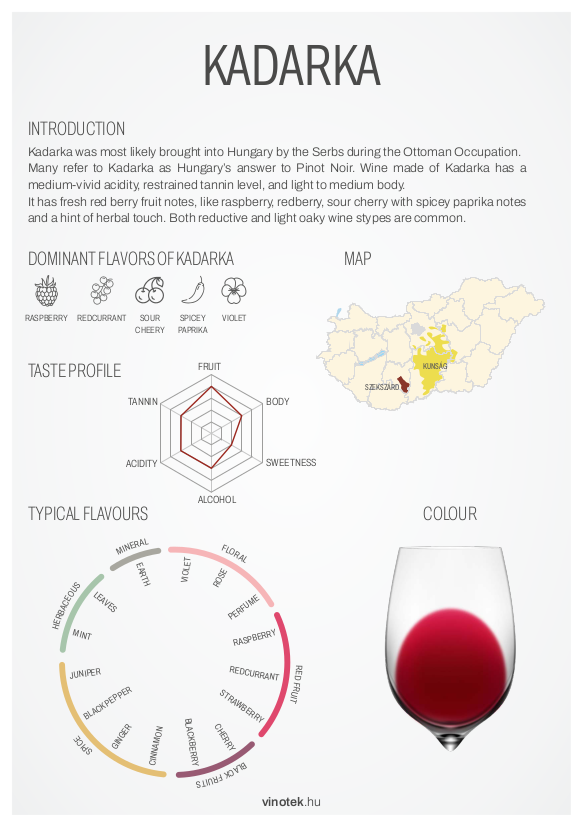
Villányi Franc and Cabernet Franc
Hungary has the fifth largest Cabernet Franc plantations after France (Bordeaux, Loire Valley), Italy, the USA (California, Washington, New York), and Chile. With more than 1400ha Within Hungary, Villány has the largest vineyard area with 336ha.
Domestically the Villányi Franc is one of Hungary’s most well-known premium red wine brands of Hungary. Internationally Villányi Franc has massive potential on the global market, like premium quality solely Cabernet Franc-made varietal red wine. Apart from the Loire, few wine regions produce Cabernet Franc-like varietal wines. Within these regions, none of them represent such a unique Mediterranean style, mature red wine as Villányi Franc.
The harvest in Villány is somewhat predictable between the last week of September and mid-October. With vivid-mid acidity, high velvety tannin, fuller body, and quite intense flavor characters, the structure of the Villányi Franc is heavier than the available thinner Loire style.
The Villányi Franc flavors are riper and more profound than the Loire valley Cabernet Franc, mostly black fruits such as black cherry, black plum, and blueberry combined with some red fruits such as sour cherry, cherry, red currant, and raspberry. Due to the use of small oak, some black pepper with earthy character, and abundant sweet, dark chocolate and tobacco.
You can find Cabernet Franc in several Hungarian wine region as a single variety bottling. For example, the Figula Cabernet Franc won a bronze medal on Decanter World Wine Award in 2021, and Marianum from Babarczi Pincészet (Pannonhalma Wine Region) won the 2022 Award.
One of our favorites is Infusio from Pannonhalma Abbey Winery, and its second-label red blend, Hemina, is a value-for-money choice. It is also a popular variety in Eger and Szekszárd, where it is allowed type in Bikavér blends. It gives the backbone of many other blends in Hungary.
Portugieser
Villány’s second variety in terms of area is produced in several other wine regions. It was probably brought to Villány by the settling Swabians. Formerly known as ‘Oporto,’ the variety probably originated in Spain but is produced in small quantities in many countries. It ripens early and makes a pleasant, juicy, slightly tannic, easy-drinking wine unsuitable for long aging and not the best choice for winegrowers regarding yield security, as it has a thin skin and is, therefore, more susceptible to disease.
We have two Portugiesers in our range, both from Villány. The Vylyan Winery has a Portugieser called Macska (Cat) and the A. Gere Winery has a Portugieser.
Bordeaux style blends
Every year, Bordeaux-style blends from different wineries achieve good results in major international competitions. In the 2022 DWWA competition, Thummerer Pincészet’s Vili Papa Egri Cuvée Superior from Eger wine region won a gold medal (96 points), while Szende Pincészet’s St. Urbanus Cuvée from Villány won a silver medal (90 points). In the 2021 competition, Sauska Pincészet’s Cuvée 7 from Siklós also won a gold medal (96 points). So there is no shortage of results. And there’s more.
Overall, the Hungarian Bordeaux blends represent excellent value for money, both in the midfield and among the top wines. The Cabernet Sauvignon predominant wines tend to come from the southern part of the country (Villány and Szekszárd) and the Balaton area. In the country’s other regions, Cabernet Franc‘s predominant blends are more typical, often with cask Cabernet Franc and Merlot and Cabernet Sauvignon completely absent.
The character of the wines is primarily shaped by the barrel, which is made mainly of Hungarian oak by most producers, but many age these blends at least partially in French oak barrels. Aromas include blackcurrant, pepper, cedar, leather, cinnamon, leather licorice, and coffee. In many cases, the fruitiness is combined with a robust jammy character.
We have collected the top Hungarian reds from our inventory to a six bottle selection. It has three Bordeaux blends: Pannonhalma Infusio, Gere Kopar and Vylyan Duennium. In Kopar there is a small quantity of Cabernet Sauvignon beside Cabernet Franc and Merlot. In Infusio and Duennium only Cabernet Franc and Merlot only.
Old Hungarian varieties that you might find on the shelves
We want to highlight two varieties from this segment: Csókaszőlő and Fekete Járdovány.
Csókaszőlő
The Csókaszőlő is, to the best of our knowledge, one of the oldest Carpathian Basin red grapes. More and more vines are being cultivated again, especially in Villány and around Lake Balaton.
It is believed that the word “csóka” used to mean black grape, also called “wild black.” It is thought to have similarities with the kadarka but contains more coloring matter than the kadarka. It was probably the basis of the “Buda red” (a famous blend produced around the Hungarian capital city) blended with the kadarka. According to old records, the two species were often blended throughout Hungary.
The wines made from it could be placed along the pinot noir, kadarka line, perhaps even stylistically not too far from kékfrankos. Regarding aromatics, it is characterized by cherries and sour cherries alongside spices, with fresh acidity, restrained, soft tannins, pronounced alcohol and a medium body. It is basically a red berry fruit wine with more restrained aromas, low tannin, firm acidity and medium intense color. As a lighter-style wine, it works well on its own or with light dishes, and its kind makes it a pleasant wine to drink all year round. It accompanies roasted vegetables, light roasts, stews, lecsó, casseroles, lasagna, meatballs with tomato sauce, and fish soup, but also goes well with root vegetables, potatoes, artichokes, beetroot, aubergines, celery, tomatoes, more mature cheeses, camembert, goose, duck, game birds, pork, veal, and lamb dishes. Still, it is also a good choice for other lighter Hungarian dishes. Because of its character, it is best consumed fresh, in the latest vintages, and should be consumed within a few years.
Fekete Járdovány
The other tasty and noteworthy grape in this category is Fekete Járdovány, brought back into production by the A. Gere Winery. The Fekete járdovány (Fekete means black and járdovány means járdovány – so we don’t know) is an ancient Carpathian Basin grape variety, which was widespread in the territory of then Hungary in the pre-Philoxera times.
Its color is more profound than the average, youngish. Hue turns purple with carmine reflexes. Its nose is spicy with blackberries and very lively. In its taste: mainly coffee, sour cherry, redcurrant, and white pepper appear. When tasted, pleasant acids matched with firm tannins. It ends with a flavoury, long-lasting fruity sip.
Hungarian red wines in Vinotek.hu shop
-
 A. Gere – Solus – Merlot€45,72
A. Gere – Solus – Merlot€45,72 -
 A. Gere – Attila Cuvée€114,30
A. Gere – Attila Cuvée€114,30


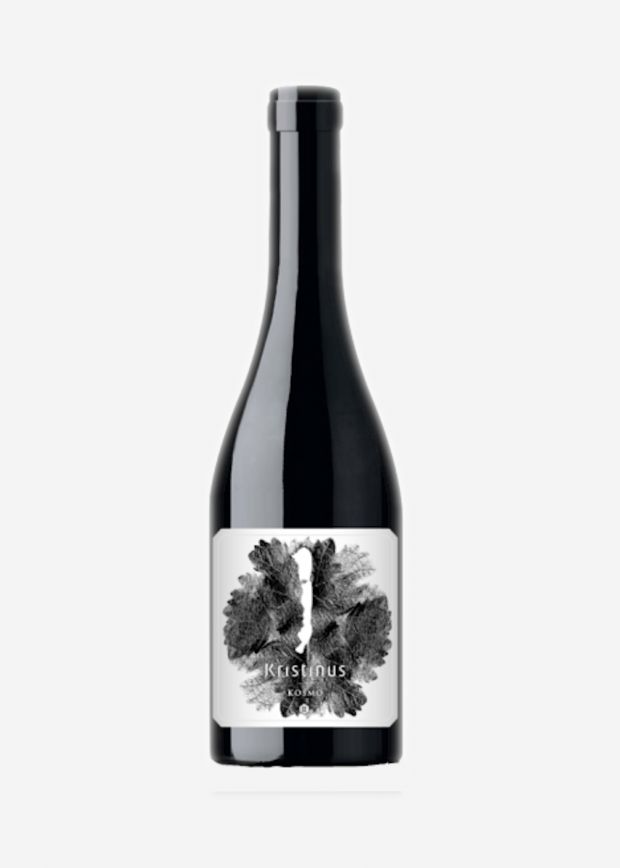


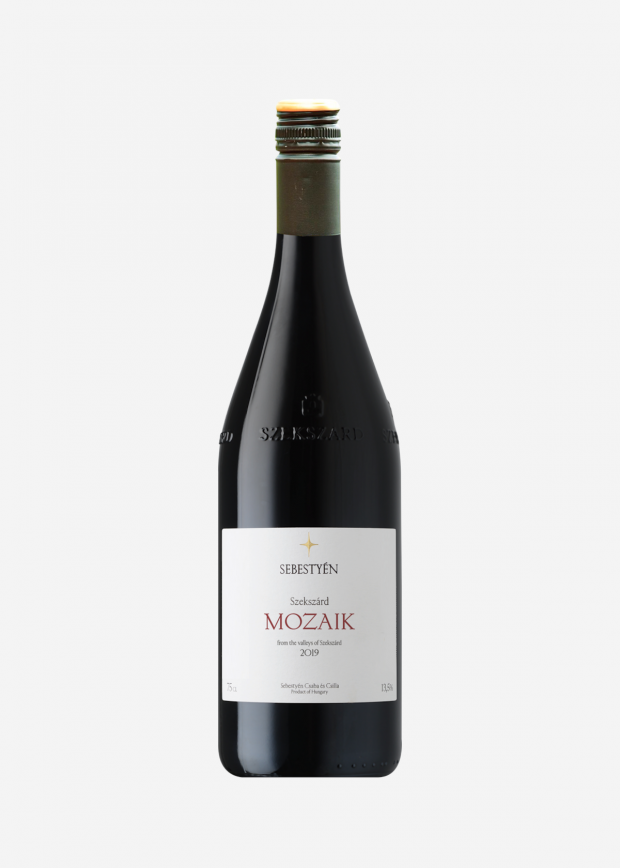


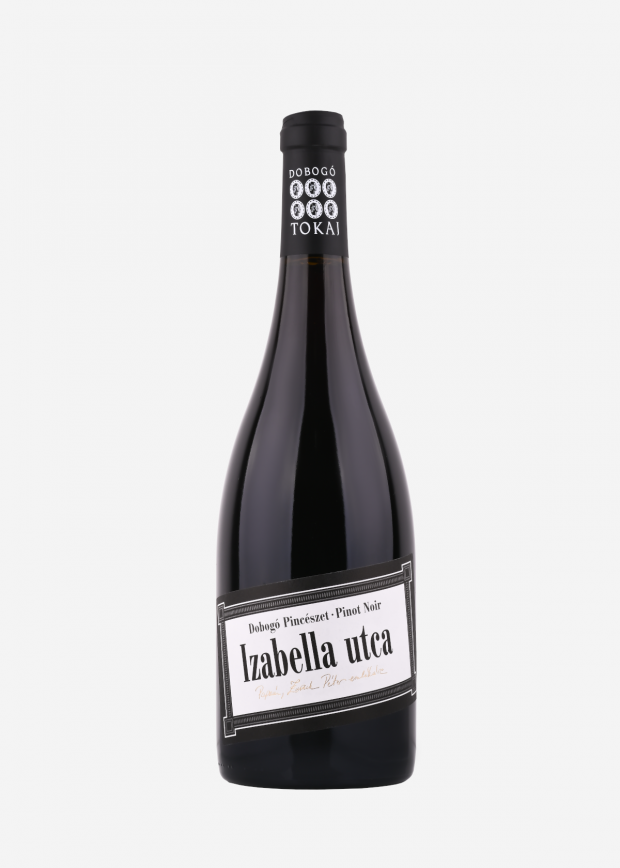
2 Comments for “Hungarian red wines”